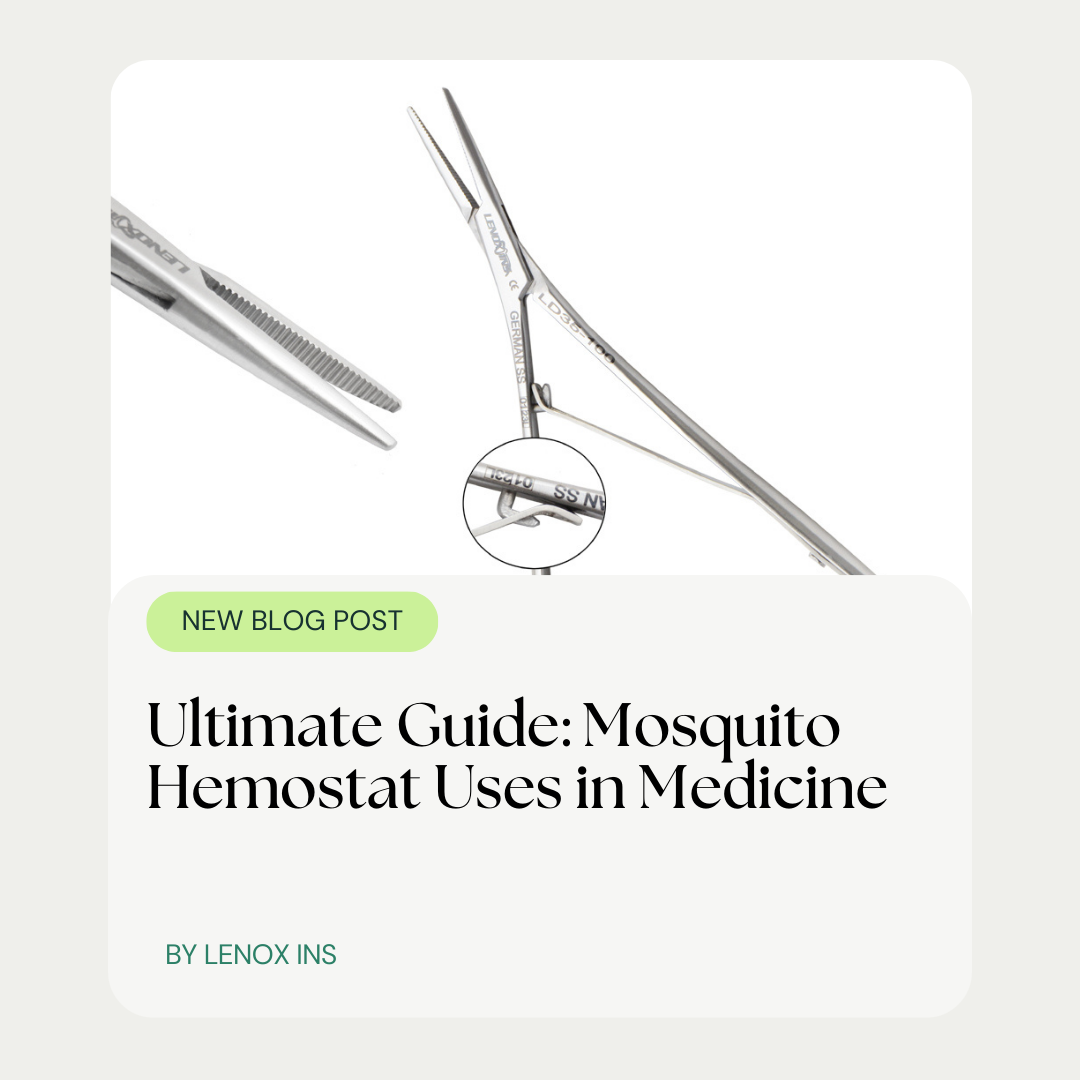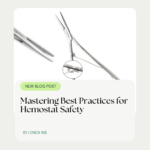Ultimate Guide: Mosquito Hemostat Uses in Medicine
- lenoxinstro
- November 28, 2024
- Dental Instruments, Tissue Forceps

Surgeons and medical professionals, have you ever faced the challenge of controlling bleeding in tight spaces? Understanding the versatility and precise control offered by the mosquito hemostat can be a game-changer in your practice. This article dives into its primary uses in surgical procedures, with a focus on delicate tasks like gripping fine tissue and securing small blood vessels. We will discuss specialized applications in fields like orthodontics, where precision is paramount, and outline essential techniques for the proper handling and maintenance of your instruments, ensuring their longevity. By illuminating the value and efficiency that the right hemostat brings to the operating room, we aim to help you enhance patient outcomes while also considering cost-effective practices that accommodate your budget. Navigate your way to the best practices for care, sterilization, and selection, and let’s add this vital instrument to your surgical cart with confidence.
Understanding the Mosquito Hemostat in Medical Practices
The mosquito hemostat stands as a crucial instrument in medical practices, known for its precision in dissection and ligature. Recognized for its distinctive design that incorporates fine tips, a useful ratchet locking mechanism, and dual-use as a needle holder, this tool has evolved significantly since its original inception. In contrasting mosquito hemostats with other hemostatic devices, we notice variations in functionality and suitability for different surgical scenarios. This exploration grants insights into these specialized instruments’ unique characteristics and their integral role in advancing medical procedures. mosquito hemostat
Design and Features of Mosquito Hemostats
The design of the mosquito hemostat boasts a fine-tipped end, offering unparalleled precision during delicate surgical tasks. Unlike typical scissors, these forceps are crafted to maintain control, even in confined spaces, and their resistance to corrosion ensures longevity and reliability. Surgeons often rely on the scalability of this tool, which ranges from clamping minute blood vessels to securing sutures with its refined jaw structure.
Employing a mosquito hemostat during medical procedures guarantees meticulous handling of tissues which is vital for patient recovery. The instrument’s unique ratchet locking mechanism allows clinicians to secure the gripping position without continuous pressure, providing stability crucial for intricate operations. This unmatched functionality, paired with the hemostat‘s durability, streamlines various surgical processes, solidifying its place as an indispensable piece of equipment in healthcare settings.
Historical Evolution and Significance
The historical progression of the mosquito hemostat is as fascinating as it is significant in surgical advancement. Originally a simple handheld tool for holding tissue secure, its evolution was marked by advancements in both blade precision and control mechanics. Surgeons found the slim profile and fine tips conducive to managing the intricacies of human anatomy, aiding in the minimization of tissue trauma during procedures.
Incorporating materials impervious to degradation, the modern mosquito hemostat now offers surgeons a robust instrument for delicate tissue manipulation. Its ratchet locking feature was a game-changer, allowing fingers to remain steady while clamping vessels or sutures. This innovation elevated the functionality of the mosquito hemostat, prompting many healthcare professionals to see it as indispensable, often prompting them to recommend to colleagues, “Add to cart, this is a must-have for your surgical toolkit.”
Comparing Mosquito Hemostats to Other Hemostatic Instruments
In veterinary medicine, the mosquito hemostat is often juxtaposed with other hemostatic instruments to discern its optimal use cases. For instance, during laparoscopy in smaller animals, its fine beak allows for more precise manipulation and clamping of delicate tissues compared to broader-tipped tools, which may be too cumbersome for such specialized work. Clinicians find the mosquito hemostat‘s size and precision effective when working within the narrow confines of endoscopic procedures, where control and visibility are paramount.
Contrasting the mosquito hemostat with electrosurgery devices also provides compelling insights. While electrosurgery offers the advantage of cutting and coagulating tissues using heat, the mosquito hemostat provides a mechanical precision that is indispensable in surgeries requiring meticulous hemostasis. Moreover, its non-electric nature means there’s no risk of thermal damage to surrounding tissues, making it a preferred choice for surgeries where thermal spread can be particularly detrimental.
Primary Uses of Mosquito Hemostats in Surgery
In the realm of surgery, the mosquito hemostat emerges as an indispensable surgical instrument. Crafted from durable stainless steel, it’s adept at clamping small blood vessels, controlling hemorrhage within delicate tissues, and assisting with suturing and precise tissue manipulation. Its use is widespread across the United States, reflecting its adaptability and effectiveness. This section delves deeper into these primary applications, illuminating how the mosquito hemostat contributes substantially to successful surgical outcomes.
Clamping Small Blood Vessels Effectively
During surgical interventions, the control of bleeding is paramount. Mosquito hemostats, often referred to as Halsted mosquito forceps, are the pliers of choice for clamping small blood vessels with unparalleled efficiency. Their slender, fine-tipped design allows for precise application, ensuring the vessel is securely gripped without causing undue damage to surrounding tissues.
These forceps play a crucial role in both emergency and planned surgeries, fostering rapid cessation of bleeding and contributing to a clearer surgical field. The forceps’ description as both a delicate and robust tool underlines its importance; practitioners find it essential for maintaining hemostasis when working with small vessels. As such, the mosquito hemostat continues to be a staple in the medical field, providing solutions to one of the most common pain points in surgery – effective blood management.
Controlling Hemorrhage in Delicate Tissues
When dealing with the delicate task of controlling hemorrhage in sensitive tissues, the mosquito hemostat demonstrates its proficiency through its steel construction and precise jaw design. Surgeons find that the hemostat‘s ability to gently yet firmly grip blood vessels provides an essential balance, minimizing the risk of further trauma while securing hemostasis. This often leads to better health outcomes, as the fine control it offers is critical in surgeries involving highly vascular organs or intricate structures.
The retractor qualities of these hemostats further enhance their functionality in managing bleeding. As they anchor and maintain the position of small blood vessels, the surrounding tissue is spared from unintentional contact, enabling a clearer view and better surgical precision. The adaptability and reliability of the mosquito hemostat make it an invaluable tool for healthcare providers aiming to mitigate blood loss while preserving the integrity of the operative site.
Assisting in Suturing and Tissue Manipulation
The adeptness of mosquito hemostats extends beyond controlling bleeding, playing an essential role in suturing and tissue manipulation. Notably in dental surgeries where precision is key, this instrument helps in guiding a needle through tissue with control and stability that is vital for effective cauterization and wound closure, potentially reducing operative times and improving patient outcomes. Such applications solidify the hemostat‘s status in orders shipped to dental clinics worldwide.
Additionally, mosquito hemostats serve an irreplaceable function in securing tissues during procedures that require drilling or manipulation of delicate structures. By providing a firm hold on tissue and minimizing involuntary movements, surgeons can prevent unwanted bleeding and ensure a clearer field of operation. This instrument’s tactile precision and reliability commonly lead to it being top-listed in medical supply orders shipped to hospitals and clinics.
Specialized Applications Across Medical Fields
The mosquito hemostat‘s versatility extends into a variety of medical fields, each with unique demands. In cardiovascular procedures, this precision instrument, often made from tough tungsten, is essential for its fine length and grip on delicate vessels. Neurosurgical operations benefit from its capacity to maneuver in tight spaces, handling sensitive neural tissues. For plastic and reconstructive surgery, the mosquito hemostat is indispensable in skin grafting and other detailed work, complementing tools like the skin stapler. Furthermore, in veterinary medicine, its reliable clamping and gentle handling of tissues aid in procedures on various species, upheld by strict sterilization protocols. This section explores the specialized applications that underline the instrument’s significance across diverse medical practices.
Utilization in Cardiovascular Procedures
In cardiovascular procedures, the mosquito hemostat‘s precise control over tiny vessels becomes particularly vital. Surgeons employ its slim, fine tips, often constructed from strong titanium, to delicately manage the suturing of vessels or the positioning of a cannula, minimizing the risk of damage to sensitive cardiac tissues. These instruments, with their ability to maintain a firm hold with minimal tissue trauma, are indispensable tools for surgical teams dealing with the heart’s intricate structures.
The refined design of the mosquito hemostat ensures that small, yet critical, areas within a surgical site remain free from undue pressure or manipulation. With a mosquito hemostat in hand, surgeons are able to grasp and secure minuscule blood vessels, a process that demands high levels of precision and often involves the use of thin, tooth-like serrations that provide a non-slip grip. Its application reinforces the surgical team’s ability to perform complex cardiovascular interventions with confidence and dexterity.
Role in Neurosurgical Operations
In the precise and high-stakes realm of neurosurgical operations, the mosquito hemostat‘s role is underscored by its ability to maneuver within the limited confines of the cranial cavity. Made with materials such as tungsten carbide, these forceps offer the robustness and fine control essential when handling soft neural tissues or delicately lifting a sinus membrane during a sinus lift procedure. They provide surgeons with the confidence to operate near critical structures, ensuring patient safety and surgical accuracy.
German-engineered mosquito hemostats, renowned for their quality and precision, are particularly sought after when securing or removing tiny screws in skull-based surgeries. The exacting nature of neurosurgery demands tools that can be deftly managed to prevent any inadvertent damage, making the mosquito hemostat a vital component in neurosurgeons’ operative repertoires. This level of instrumental precision contributes significantly to positive patient outcomes in neurosurgical practices.
Importance in Plastic and Reconstructive Surgery
In plastic and reconstructive surgery, the mosquito hemostat‘s finesse is unparalleled when it comes to delicate tissue handling and suture placement. Its presence is as commonplace as the scalpel, catering to the meticulous nature of activities such as graft preparations, flap surgeries, or precise excisions. The tool’s lightweight design and fine tips allow practitioners to handle tissues with the necessary gentleness, ensuring minimal scarring and optimal aesthetic outcomes for the patient.
The mosquito hemostat is employed not only in procedures involving human patients but also extends to surgeries in veterinary medicine, addressing animal health. Surgeons appreciate the hemostat‘s ability to precisely control bleeding and manipulate tissues, which is crucial in the delicate work of animal reconstructive procedures. The hemostat‘s precision ensures that the surgical site is exposed clearly, which is particularly critical when working with the smaller anatomical features of some animal species.
Use in Veterinary Medicine
In veterinary medicine, the mosquito hemostat is particularly valued for its precision when treating smaller patients, such as birds, reptiles, and small mammals. Its ability to firmly clamp onto tiny vessels is indispensable during complex procedures, reducing the risk of excessive bleeding in these delicate creatures. Veterinarians often opt for this instrument as it affords them the control necessary for precise surgical intervention, crucial to the successful treatment and recovery of animal patients.
Moreover, the mosquito hemostat has become integral for spay and neuter operations, a staple in veterinary practices. The hemostat‘s slender design and precise grip allow vets to navigate through the limited surgical exposure typical of these procedures, ensuring a swift and safe process. This tool not only aids in controlling bleeding but also enhances the veterinarian’s ability to manage soft tissues with confidence and exactness, contributing substantially to improved outcomes in animal healthcare.
Techniques for Proper Handling of Mosquito Hemostats
Mastering the use of mosquito hemostats is critical for surgical precision and efficiency. This section outlines essential techniques for ensuring optimal grip and control, strategic positioning for maximum efficacy, and seamless integration with other surgical instruments. By honing these skills, medical professionals enhance their ability to perform successful procedures. The following topics offer valuable insights into the practical application of mosquito hemostats within a medical setting.
Ensuring Optimal Grip and Control
Proper grip and control of a mosquito hemostat are fundamental for its effective use during surgical procedures. Surgeons must ensure that the forceps are held between the thumb and the first two fingers, allowing for a stable and precise manipulation of the tool. This approach is critical for actions like clamping small vessels or grabbing delicate tissues, ensuring that the surgical process proceeds smoothly with minimal risk to the patient.
Understanding the delicate balance between a firm grip and gentle handling is crucial when using mosquito hemostats. Medical professionals are trained to apply the right amount of pressure to secure tissues without causing damage, a skill that is particularly important when working within confined anatomical spaces. The locking mechanism of the hemostat should be engaged thoughtfully, preserving tissue integrity while providing the necessary hold throughout various stages of an operation.
Positioning for Maximum Efficacy
Positioning a mosquito hemostat for maximum effectiveness is pivotal in performing a precise and successful surgery. Surgeons must navigate the instrument to grip at an angle conducive to both visibility and accessibility, which often involves aligning the beak perfectly with the vessel or tissue in question. Strategic placement is particularly crucial when working in deep or narrow cavities, where precision can significantly affect surgical outcomes.
The efficacy of a mosquito hemostat also hinges on avoiding obstruction of the surgical field. It is integral to ensure that once clamped, the handles are positioned out of the way of other instruments and the surgeons’ hands. This careful maneuvering not only maintains a clear view for the surgeon but also maximizes the functionality of the hemostat without compromising the efficiency of the procedure.
Integrating With Other Surgical Instruments
Effective orchestration of surgical instruments hinges on the seamless integration of the mosquito hemostat with other tools at the surgical table. When aligning a mosquito hemostat alongside scalpels, retractors, or suture needles, practitioners ensure a synergistic workflow that optimizes the surgical process. This tactical integration allows for quick transitions between clamping and cutting or suturing, maintaining the flow of the procedure while prioritizing patient safety.
Practical experience reveals the critical nature of a mosquito hemostat‘s role in complex surgeries where coordination is key. For instance, during suturing, the hemostat‘s stability assists in the meticulous handling of needle drivers, streamlining the closure of incisions. The deliberate coordination among instruments avoids interference and maintains sterility, exemplifying the hemostat‘s pivotal contribution to the precision and efficacy of surgical outcomes.
Maintenance and Sterilization Protocols
Maintaining the integrity of mosquito hemostats in clinical settings hinges on stringent cleaning and sterilization protocols. This forthcoming section delves into the precise cleaning procedures that are crucial for preventing contamination, sterilization methods that adhere to established healthcare standards, and essential tips for extending the lifespan of these vital surgical instruments. By embracing these practices, medical professionals can ensure the durability and sterility of hemostats, bolstering patient safety and enhancing the overall quality of care.
Cleaning Procedures to Prevent Contamination
Ensuring that mosquito hemostats are free from contaminants is a vital procedure in safeguarding patient health. The initial cleaning process involves thoroughly rinsing the instruments to remove any biological debris, a critical step before moving on to more rigorous sterilization methods. Professionals in the medical field recognize that meticulous cleaning not only prevents the transmission of infectious agents but also extends the lifespan of the instruments, adding value to healthcare practices.
After rinsing, the hemostats undergo careful scrubbing using detergents designed for surgical tools to effectively break down residues. It’s critical that each crevice and mechanism, especially the ratchet lock, is cleaned to remove any trapped particles. This attention to detail during the cleaning phase is a foundational aspect of infection control protocols and reinforces the quality of patient care delivered by healthcare facilities.
Sterilization Methods in Compliance With Standards
To ensure compliance with healthcare standards, sterilization of mosquito hemostats requires autoclaving, a method known for its effectiveness in destroying microorganisms. The autoclave subjects these precision instruments to high-pressure saturated steam at a regulated temperature, typically 121 degrees Celsius for a specific amount of time, effectively eliminating potential pathogens. This sterilization process is vital in preventing cross-contamination between patients and is a standard practice in medical facilities worldwide.
Medical practitioners also rely on chemical sterilants as an alternative to high-temperature methods to preserve the integrity of mosquito hemostats. Solutions containing glutaraldehyde or other high-level disinfectants provide a viable option when heat-sensitive instruments must be made pathogen-free. These chemical protocols are meticulously followed, ensuring that each hemostat meets the stringent aseptic conditions required for safe and successful medical interventions.
Tips for Prolonging Instrument Lifespan
To foster a longer lifespan for mosquito hemostats, regular inspection plays a pivotal role. Medical staff are urged to examine these instruments for any signs of wear or damage, such as misalignment of the tips or malfunctioning of the ratchet mechanism, which can impede their effectiveness in procedures. Proactive detection and replacement of compromised hemostats safeguard against instrument failure during critical medical practices, ultimately ensuring continuous, dependable performance.
Another key practice is the proper storage of mosquito hemostats post-sterilization. Ensuring these instruments are kept in a dry, organized environment prevents the development of rust and deterioration of the metal, which are common issues that affect the functionality and safety of surgical tools. By adhering to these storage guidelines, healthcare professionals maintain the hemostat‘s structural integrity, which is essential for their precise application in surgeries.
Choosing the Right Mosquito Hemostat for Your Practice
Selecting the right mosquito hemostat for your practice involves careful consideration of size, material, and the specific requirements of surgical procedures. Appropriate sizes and variations cater to diverse clinical needs, while the choice of material impacts both functionality and longevity. Factors such as tissue type and the intricacy of surgical maneuvers guide practitioners in choosing the ideal hemostat. This subsection will delve into the critical aspects of selection, providing medical professionals with practical advice for optimizing tool performance in their specialized settings.
Selecting Appropriate Sizes and Variations
Selecting the right size and variation of mosquito hemostat for a medical practice hinges on the specific requirements of the surgical procedures conducted. The range of sizes from petite to larger configurations allows for precise matching with varied surgical needs, ensuring that practitioners achieve optimal control and dexterity during operations. This adaptability is a cornerstone for improving patient outcomes and procedural accuracy, making size and variation a critical decision point for clinicians.
Understanding the anatomical intricacies and the delicate nature of the tissues involved guides medical professionals in their selection of mosquito hemostats. A pediatric surgeon, for instance, would typically require smaller, more delicate hemostats compared to a general surgeon. This tailored approach not only prevents tissue trauma but also enhances the surgeon’s ability to navigate through the surgical site, addressing the needs and pain points of both the practitioner and the patient effectively.
Material Choices and Their Implications
The choice of material for mosquito hemostats is not just a matter of durability, but also of surgical efficacy. Stainless steel variants offer longevity and are less likely to harbor bacteria, reducing post-surgical infection risks. Tungsten carbide tips, on the other hand, are valued for their sharpness and precision, making them ideal for manipulating tiny vessels and delicate tissues, a fact surgeons considering the best tools for their practice can’t ignore.
When selecting mosquito hemostats, clinicians must also weigh the implications of material reactivity on tissue integrity. Instruments crafted from inert materials like titanium minimize the risk of allergic reactions and improve patient safety, particularly in sensitive procedures. This consideration directly caters to the need for personalized care in surgical interventions, ensuring patients receive the most suitable treatment without unwarranted complications.
Factors to Consider for Specific Surgical Needs
When determining the ideal mosquito hemostat for specific surgical interventions, practitioners should evaluate the procedure’s complexity and the tissue type involved. For intricate operations such as microvascular procedures, a hemostat with ultra-fine tips ensures the high level of precision needed for manipulating minuscule blood vessels. This careful selection aligns the tool’s capabilities with the demands of minute surgical tasks, thereby enhancing the surgeon’s control and patient outcomes.
The tactile feedback provided by a mosquito hemostat is another critical factor for surgeries that entail delicate tissue manipulation. Surgeons should prefer instruments that offer a balanced response, thereby facilitating nuanced handling without causing undue pressure on the tissues. Selection of the appropriate hemostat, one with a reliable locking mechanism and ergonomic design, assures that precise tissue contact is maintained, minimizing the risk of tissue damage and postoperative complications.
Conclusion
The mosquito hemostat proves to be an indispensable tool in medical practices, thanks to its precise manipulation of delicate tissues and unparalleled control over small blood vessels. Its unique design and evolution cater to a spectrum of surgical needs, from cardiovascular to microvascular procedures, enhancing patient outcomes and procedural accuracy. Proper technique and maintenance are essential for maximizing the hemostat‘s efficiency and longevity, ensuring this tool remains a staple in various medical fields. Overall, the mosquito hemostat‘s functionality, adaptability, and precision underscore its critical role in advancing surgical practices and improving patient care.





